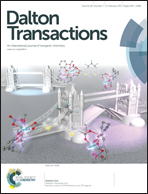Microwave-assisted synthesis of the anticancer drug cisplatin, cis-[Pt(NH3)2Cl2]†
Abstract
A microwave-assisted synthesis of cisplatin, cis-[Pt(NH3)2Cl2], has been developed and optimized on both a 0.2 and 0.05 millimolar scale. The optimized synthetic procedure was modeled after the Lebedinskii–Golovnya method and is suitable for incorporating the radionuclide, 195mPt, into cisplatin for biological studies. Highest yields (47%) and purity are obtained using a K2PtCl4 : NH4OAc : KCl molar ratio of 1 : 4 : 2 at a temperature of 100 °C. The entire synthesis and purification procedure requires approximately 80 min. At a reaction temperature of 150 °C, the trans isomer is the exclusive product, suggesting that complexes of the general form, trans-[Pt(RNH2)2Cl2], can be synthesized directly from K2PtCl4 using [RNH3]OAc (R = alkyl or aryl moieties) via a microwave process. Two novel separation procedures have been developed which efficiently remove the major impurity (1 : 1 Magnus-type salt) from the crude reaction product, yielding a product of purity comparable to that obtained by the Dhara method and suitable for biological studies. These procedures are applicable to both the micro- and macro-scale of synthesis. The question of whether this microwave-assisted synthesis of cisplatin will be a preferred method for incorporating 195mPt into cisplatin is yet to be determined.
![Graphical abstract: Microwave-assisted synthesis of the anticancer drug cisplatin, cis-[Pt(NH3)2Cl2]](/en/Image/Get?imageInfo.ImageType=GA&imageInfo.ImageIdentifier.ManuscriptID=C4DT03617D&imageInfo.ImageIdentifier.Year=2015)

 Please wait while we load your content...
Please wait while we load your content...